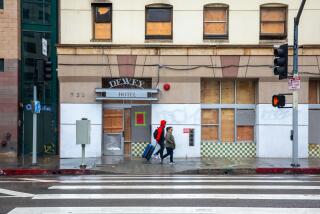How a SCI-Arc design spoof predicted New York’s ‘poor doors’

My mom likes to say that she left South America for the Land of Opportunity, only to have South America follow her here. It’s our bit of gallows humor for talking about rising economic inequity here in the United States — an inequity that appears to be increasingly written into our architecture.
On Sunday the New York Post reported that the city of New York had approved a “poor door” for a luxury condo development on Manhattan’s Upper West Side. That is, a separate entrance for tenants of the building’s affordable-housing units. Naturally, this is already causing waves — in one, two and three parts — on the Internet.
Certainly, there are places in the world where a “poor door” might not seem like a big deal. In South America, where my mother is from, inequitable architecture is simply par for the course. The well-to-do live in sprawling apartments and large homes. The live-in servants they employ generally inhabit small, cell-like rooms, adjacent to a kitchen or a garage, with just enough space for a single bed and television. Daylight isn’t always an option.
And of course there’s Dubai, the playground for the wealthy in the United Arab Emirates, where the workers who build and staff the city are confined to the squalid encampments at its outskirts.
This type of class separation through design isn’t entirely new in the United States. Many of our buildings have service entrances (though presumably, these aren’t for people who actually live in the building). And the recent rash of stories about defensive architecture show that tactics to manipulate behavior (especially the behavior of the homeless) has become a standard aspect of urban design.
In L.A., more specifically, entire aspects of the city — gated communities, freeways, bunker-like architecture — have served to keep the races and classes apart, as Mike Davis detailed so famously in his 1990 book, “City of Quartz.”
So the idea of a “poor door” shouldn’t exactly come as a shock. Already, some buildings limit what amenities (playrooms, gyms) their low-income tenants can access. But there’s something about the concept that really seems to strike at the architectural heart of what we consider to be our egalitarian, up-by-the-bootstraps society.
After all, shouldn’t people who live in the same building all be allowed to enter it through the same door? And what does it mean to live in a society that does its best to keep the working class out of sight, out of mind?
In 2008, L.A. architect Wes Jones and the students in his design studio at the Southern California Institute of Architecture (SCI-Arc) made a spoof marketing video (embedded above) that claimed to solve the city’s worker housing problem. Billing itself as the fictional “Kartun Development Group,” the studio proposed a series of parody buildings that would contain worker housing at the core and luxury housing around the perimeter. Separate entrances would keep the two worlds invisible to each other.
More significantly, it would keep the workers invisible. Period.
“The building will blend unobtrusively into any of the high-rent sections of the city,” intoned the video’s narrator. “Such measures help to avoid banishing the workers to the outskirts of the city. But also prevents them from being on display for the patronizing pity of the more fortunate expatriates.”
Jones says that when he and his students first put the video on YouTube back in 2008, they expected it stir up some controversy.
“We were looking at the Dubai phenomenon and the way architects were trying to accommodate the new demands of global capital,” explains Jones, principal of Jones, Partners: Architecture. “We were being subversively critical of that phenomenon. So we created this fake development company to make these outrageous proposals to see if anyone blinked. But everyone thought it was par for the course.”
The video was later shown at the 11th Architecture Biennale in Venice in 2008, along with other items related to the SCI-Arc studio’s study of Dubai. Take the time to watch it. It’s only seven minutes long and it’s both terrifying and hilarious. (Part of the proposal is that all the worker housing will be outfitted with furnishings from Ikea.)
It is also frighteningly prescient. “We had the crash and it gave everyone perspective,” Jones says. “Now we’re doing the same old things.”
Only this isn’t Dubai we’re talking about — or South America or Africa. The yawning gap between rich and poor in this country isn’t just economic theory or pop psychology. It’s getting built, brick by brick, into the fabric of our cities.
More to Read
The biggest entertainment stories
Get our big stories about Hollywood, film, television, music, arts, culture and more right in your inbox as soon as they publish.
You may occasionally receive promotional content from the Los Angeles Times.







